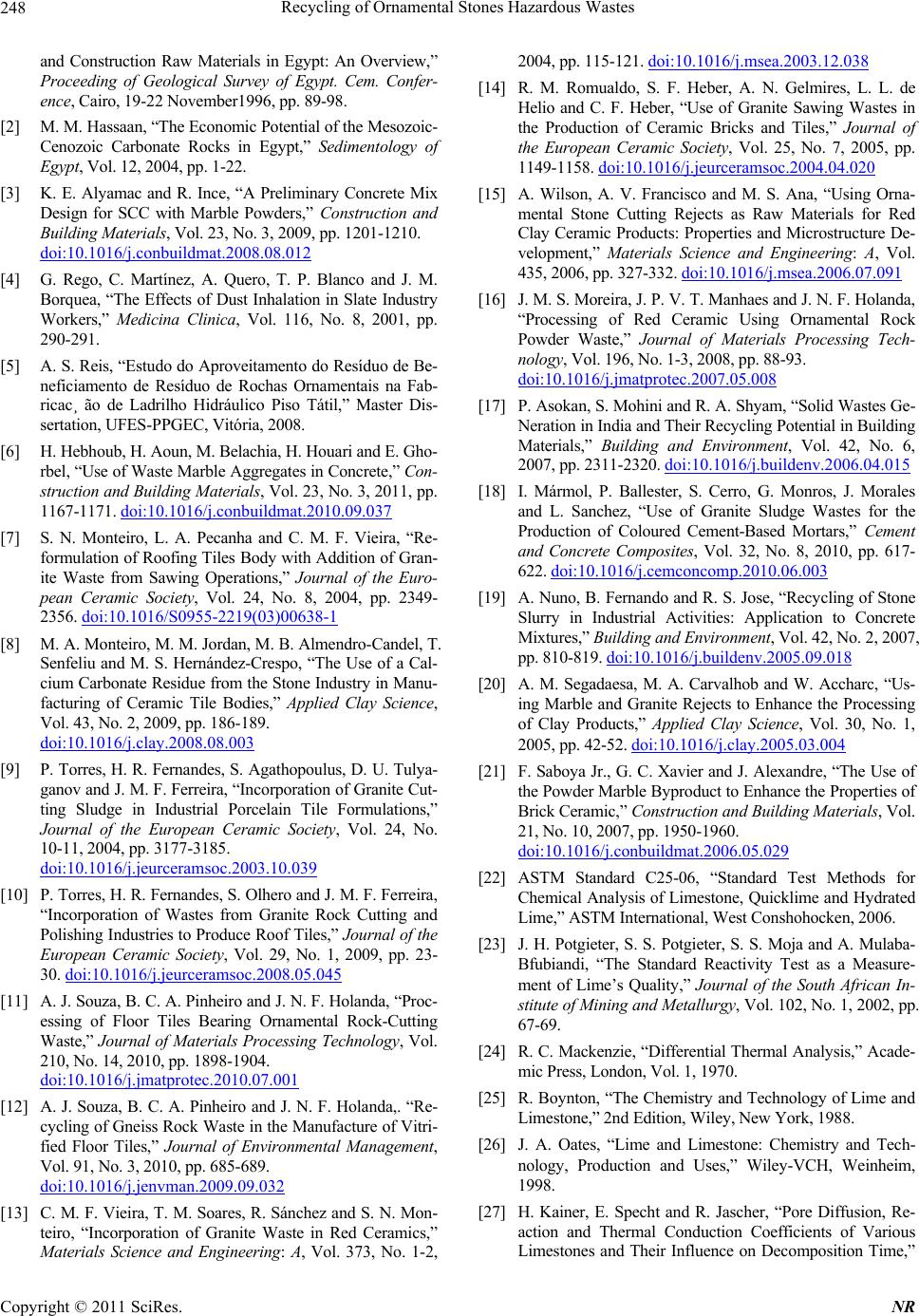
Recycling of Ornamental Stones Hazardous Wastes
248
and Construction Raw Materials in Egypt: An Overview,”
Proceeding of Geological Survey of Egypt. Cem. Confer-
ence, Cairo, 19-22 November1996, pp. 89-98.
[2] M. M. Hassaan, “The Economic Potential of the Mesozoic-
Cenozoic Carbonate Rocks in Egypt,” Sedimentology of
Egypt, Vol. 12, 2004, pp. 1-22.
[3] K. E. Alyamac and R. Ince, “A Preliminary Concrete Mix
Design for SCC with Marble Powders,” Construction and
Building Materials, Vol. 23, No. 3, 2009, pp. 1201-1210.
doi:10.1016/j.conbuildmat.2008.08.012
[4] G. Rego, C. Martínez, A. Quero, T. P. Blanco and J. M.
Borquea, “The Effects of Dust Inhalation in Slate Industry
Workers,” Medicina Clinica, Vol. 116, No. 8, 2001, pp.
290-291.
[5] A. S. Reis, “Estudo do Aproveitamento do Resíduo de Be-
neficiamento de Resíduo de Rochas Ornamentais na Fab-
ricac¸ ão de Ladrilho Hidráulico Piso Tátil,” Master Dis-
sertation, UFES-PPGEC, Vitória, 2008.
[6] H. Hebhoub, H. Aoun, M. Belachia, H. Houari and E. Gho-
rbel, “Use of Waste Marble Aggregates in Concrete,” Con-
struction and Building Materials, Vol. 23, No. 3, 2011, pp.
1167-1171. doi:10.1016/j.conbuildmat.2010.09.037
[7] S. N. Monteiro, L. A. Pecanha and C. M. F. Vieira, “Re-
formulation of Roofing Tiles Body with Addition of Gran-
ite Waste from Sawing Operations,” Journal of the Euro-
pean Ceramic Society, Vol. 24, No. 8, 2004, pp. 2349-
2356. doi:10.1016/S0955-2219(03)00638-1
[8] M. A. Monteiro, M. M. Jordan, M. B. Almendro-Candel, T.
Senfeliu and M. S. Hernández-Crespo, “The Use of a Cal-
cium Carbonate Residue from the Stone Industry in Manu-
facturing of Ceramic Tile Bodies,” Applied Clay Science,
Vol. 43, No. 2, 2009, pp. 186-189.
doi:10.1016/j.clay.2008.08.003
[9] P. Torres, H. R. Fernandes, S. Agathopoulus, D. U. Tulya-
ganov and J. M. F. Ferreira, “Incorporation of Granite Cut-
ting Sludge in Industrial Porcelain Tile Formulations,”
Journal of the European Ceramic Society, Vol. 24, No.
10-11, 2004, pp. 3177-3185.
doi:10.1016/j.jeurceramsoc.2003.10.039
[10] P. Torres, H. R. Fernandes, S. Olhero and J. M. F. Ferreira,
“Incorporation of Wastes from Granite Rock Cutting and
Polishing Industries to Produce Roof Tiles,” Journal of the
European Ceramic Society, Vol. 29, No. 1, 2009, pp. 23-
30. doi:10.1016/j.jeurceramsoc.2008.05.045
[11] A. J. Souza, B. C. A. Pinheiro and J. N. F. Holanda, “Proc-
essing of Floor Tiles Bearing Ornamental Rock-Cutting
Waste,” Journal of Materials Processing Technology, Vol.
210, No. 14, 2010, pp. 1898-1904.
doi:10.1016/j.jmatprotec.2010.07.001
[12] A. J. Souza, B. C. A. Pinheiro and J. N. F. Holanda,. “Re-
cycling of Gneiss Rock Waste in the Manufacture of Vitri-
fied Floor Tiles,” Journal of Environmental Management,
Vol. 91, No. 3, 2010, pp. 685-689.
doi:10.1016/j.jenvman.2009.09.032
[13] C. M. F. Vieira, T. M. Soares, R. Sánchez and S. N. Mon-
teiro, “Incorporation of Granite Waste in Red Ceramics,”
Materials Science and Engineering: A, Vol. 373, No. 1-2,
2004, pp. 115-121. doi:10.1016/j.msea.2003.12.038
[14] R. M. Romualdo, S. F. Heber, A. N. Gelmires, L. L. de
Helio and C. F. Heber, “Use of Granite Sawing Wastes in
the Production of Ceramic Bricks and Tiles,” Journal of
the European Ceramic Society, Vol. 25, No. 7, 2005, pp.
1149-1158. doi:10.1016/j.jeurceramsoc.2004.04.020
[15] A. Wilson, A. V. Francisco and M. S. Ana, “Using Orna-
mental Stone Cutting Rejects as Raw Materials for Red
Clay Ceramic Products: Properties and Microstructure De-
velopment,” Materials Science and Engineering: A, Vol.
435, 2006, pp. 327-332. doi:10.1016/j.msea.2006.07.091
[16] J. M. S. Moreira, J. P. V. T. Manhaes and J. N. F. Holanda,
“Processing of Red Ceramic Using Ornamental Rock
Powder Waste,” Journal of Materials Processing Tech-
nology, Vol. 196, No. 1-3, 2008, pp. 88-93.
doi:10.1016/j.jmatprotec.2007.05.008
[17] P. Asokan, S. Mohini and R. A. Shyam, “Solid Wastes Ge-
Neration in India and Their Recycling Potential in Building
Materials,” Building and Environment, Vol. 42, No. 6,
2007, pp. 2311-2320. doi:10.1016/j.buildenv.2006.04.015
[18] I. Mármol, P. Ballester, S. Cerro, G. Monros, J. Morales
and L. Sanchez, “Use of Granite Sludge Wastes for the
Production of Coloured Cement-Based Mortars,” Cement
and Concrete Composites, Vol. 32, No. 8, 2010, pp. 617-
622. doi:10.1016/j.cemconcomp.2010.06.003
[19] A. Nuno, B. Fernando and R. S. Jose, “Recycling of Stone
Slurry in Industrial Activities: Application to Concrete
Mixtures,” Building and Environment, Vol. 42, No. 2, 2007,
pp. 810-819. doi:10.1016/j.buildenv.2005.09.018
[20] A. M. Segadaesa, M. A. Carvalhob and W. Accharc, “Us-
ing Marble and Granite Rejects to Enhance the Processing
of Clay Products,” Applied Clay Science, Vol. 30, No. 1,
2005, pp. 42-52. doi:10.1016/j.clay.2005.03.004
[21] F. Saboya Jr., G. C. Xavier and J. Alexandre, “The Use of
the Powder Marble Byproduct to Enhance the Properties of
Brick Ceramic,” Construction and Building Materials, Vol.
21, No. 10, 2007, pp. 1950-1960.
doi:10.1016/j.conbuildmat.2006.05.029
[22] ASTM Standard C25-06, “Standard Test Methods for
Chemical Analysis of Limestone, Quicklime and Hydrated
Lime,” ASTM International, West Conshohocken, 2006.
[23] J. H. Potgieter, S. S. Potgieter, S. S. Moja and A. Mulaba-
Bfubiandi, “The Standard Reactivity Test as a Measure-
ment of Lime’s Quality,” Journal of the South African In-
stitute of Mining and Metallurgy, Vol. 102, No. 1, 2002, pp.
67-69.
[24] R. C. Mackenzie, “Differential Thermal Analysis,” Acade-
mic Press, London, Vol. 1, 1970.
[25] R. Boynton, “The Chemistry and Technology of Lime and
Limestone,” 2nd Edition, Wiley, New York, 1988.
[26] J. A. Oates, “Lime and Limestone: Chemistry and Tech-
nology, Production and Uses,” Wiley-VCH, Weinheim,
1998.
[27] H. Kainer, E. Specht and R. Jascher, “Pore Diffusion, Re-
action and Thermal Conduction Coefficients of Various
Limestones and Their Influence on Decomposition Time,”
Copyright © 2011 SciRes. NR